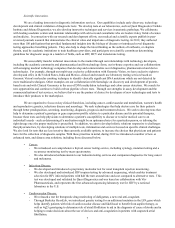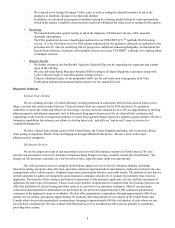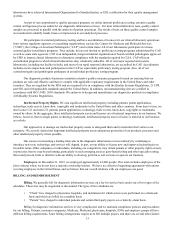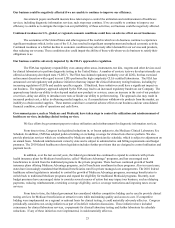Quest Diagnostics 2012 Annual Report Download - page 16
Download and view the complete annual report
Please find page 16 of the 2012 Quest Diagnostics annual report below. You can navigate through the pages in the report by either clicking on the pages listed below, or by using the keyword search tool below to find specific information within the annual report.13
other local healthcare providers, serve as our principal facilities in their service areas. Typically, we have either a majority
ownership interest in, or day-to-day management responsibilities for, our joint venture relationships.
IDNs. An IDN is a network of providers and facilities working together in providing or arranging for the provision of
healthcare. With the passage of 2010 federal healthcare reform legislation, IDNs are increasing in number and becoming more
important constituents in delivering healthcare services. IDNS may exercise operational and financial control over providers
across the continuum of care. IDNs also may function as a payer. Thus, IDNs may be able to manage the health of a
population group within a defined geography, and also may be able to influence the cost and quality of healthcare delivery, for
example though owned entities and through ancillary services. The impact of IDNs on the provision of healthcare services to
date has varied. We are actively engaging with IDNs to demonstrate the value that our services can provide to them.
Employers. Employers use tests for drugs of abuse to determine an individual's employability and his or her “fitness
for duty.” Companies with high employee turnover, safety conscious environments or regulatory testing requirements provide
the highest volumes of testing. Factors such as the general economy and job market can impact the utilization of drugs of abuse
testing. We seek to grow our employer volumes through offering new and innovative programs to help companies with their
goal of maintaining a safe and productive workplace. We also offer employers our Blueprint for Wellness® program, providing
wellness screening and analytic services to help employers and their employees manage increasing healthcare costs and
capitalize on trends in personalized health.
Other Laboratories and Other Customers. We also provide diagnostic information services to federal, state and local
governmental agencies and to other commercial clinical laboratories. These customers are charged on a fee-for-service basis.
GENERAL
Competition. While there has been significant consolidation in the diagnostic information services industry in recent
years, our industry remains fragmented and highly competitive. We primarily compete with three types of clinical testing
providers: commercial clinical laboratories, hospital-affiliated laboratories and physician-office laboratories. In recent years,
competition from hospital-affiliated laboratories has increased. Our largest commercial clinical laboratory competitor is
Laboratory Corporation of America Holdings, Inc. In addition, we compete with many smaller regional and local commercial
clinical laboratories and specialized esoteric laboratories. In anatomic pathology, additional competitors include anatomic
pathology practices, including those in academic institutions. In addition, there has been a trend among specialty physician
practices to establish their own histology laboratory capabilities and/or bring pathologists into their practices, thereby reducing
referrals from these practices.
We believe that healthcare providers traditionally consider a number of factors when selecting a diagnostic
information services provider, including:
• service capability and quality;
• accuracy, timeliness and consistency in reporting test results;
• patient insurance coverage;
• number and type of tests performed;
• pricing;
• access to medical/scientific thought leaders for consultation;
• number, convenience and geographic coverage of patient service centers;
• reputation in the medical community;
• healthcare information technology solutions;
• qualifications of its staff; and
• ability to develop new and useful tests.
We believe that we are an effective competitor in each of these areas. We also believe that offering the most attractive
service offering in the industry, including the most comprehensive test menu, innovative test and information technology
offerings, a superior patient experience, a staff including medical and scientific experts, strong quality and unparalleled access
and distribution, provides us with a competitive advantage.
We believe that large diagnostic information services providers may be able to increase their share of the overall
diagnostic information services industry due to their large networks and lower cost structures. These advantages should enable
larger providers to more effectively serve customers, including members of large health plans. In addition, we believe that
consolidation in the diagnostic information services industry will continue. However, a significant portion of clinical testing is
likely to continue to be performed by hospitals, which generally have affiliations with community physicians that refer testing
























